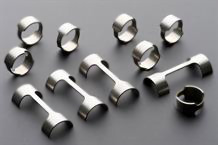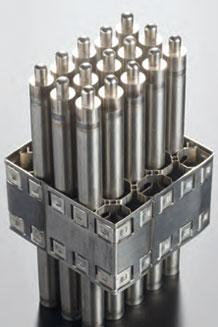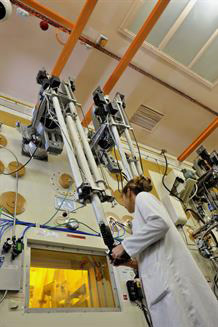Specificities of nuclear materials
Cladding for containing fuel pellets, internal structures for holding the cladding in place, and reactor vessel structures hold no secrets for the highly specialised teams at the CEA Nuclear Energy Division. Their job involves much more than straightforward industrial development. As explained by Pascal Yvon, deputy-director of nuclear activities at Saclay: "
A reactor core is a facility unlike any other. The parts inside a reactor core are not only subjected to mechanical, thermal and chemical loads like in conventional industrial plants, but they are also irradiated by neutrons emitted by the fuel during fission reactions. These neutrons change the composition and internal structure of the materials. Neutrons are therefore capable of deforming the core components and rendering them less resistant to impact and corrosion. In any case, they can completely modify the inherent properties of materials!"
Predicting the behaviour of alloys
The CEA's ambitious objective is to develop a science that is capable of predicting the behaviour of metal alloys placed in such environments. And this over periods of time covering several decades for steels used to make reactor vessels, as it is impossible to replace this component once installed. Succeeding in this task thus requires proceeding carefully step by step since the safety and operation of power plants depends on it. This first involves collecting as much information as possible on the properties of the materials used, such as their microstructure, resistance,
ductility and corrosion. Any changes to these steels, zirconium alloys and other composites resulting from their exposure to neutrons must then be identified by means of test campaigns in large experimental tools capable of simulating material ageing due to irradiation. Neutrons modify the chemical composition of materials through the transmutation or generation of helium and hydrogen via nuclear reactions. They can also cause some atoms to be ejected from the material by a ballistic effect, thus considerably agitating the atoms. Lastly, researchers must also be able to model all of these phenomena, ranging from events on an atomic scale right through to assessing their effects on the facility itself.
The key issues of today’s reactors…
The CEA's actions in this field have a dual-fold purpose. The first is to support the current reactor fleet when requested by the industry, e.g. within the scope of writing regulatory documents that EDF must provide to the ASN (French Nuclear Safety Authority) every ten years to extend the operating life of their nuclear power plants. This may involve conducting studies on the ageing of vessel steels in standard areas or in specific areas (welds, thermally loaded areas, etc.), or collecting data to better plan lengthy and complex maintenance operations, such as changing baffle assembly screws in the core at regular intervals. "Another example concerns the fuel cladding, which is the first
containment barrier in a reactor. Our objective is to increase their lifespan under normal operating conditions and to improve their safety features in the event of an accident, such as a loss-of-coolant accident following the failure of the reactor's primary system", explained Pascal Yvon.

Test specimens used to assess the mechanical behaviour of a steel tube. © P.Stroppa/CEA

Portion of the fuel assembly © P.Stroppa/CEA
1 At the Department of Nuclear Materials on the Saclay centre and at the Centre for Nuclear Spectrometry and Mass Spectrometry (UMR CEA/CNRS/Université Paris-Sud)
2 In service at the CEA Saclay Centre since 1959
3 Fuel rod cladding is first sent to the CEA Atalante laboratory in Marcoule to be separated from the fuel
4 Designed by the CEA in 2011 and 2013

Remote control handling in the hot cells of the M line at the LECI laboratory © P.F. Grosjean/CEA
… and those of tomorrow
The second has the CEA looking firmly into the future. The CEA is leading France's research on the fourth generation of nuclear systems and is focusing its efforts on two reactor technologies: sodium-cooled fast reactors in the near term and gas-cooled fast reactors in the longer term. Yet the conditions found in the core of these types of facilities are very different to those existing in pressurised water reactors which comprise the current fleet. Higher temperatures, coolants with different chemical properties, and neutrons with different energy levels. At the end of the day, the scientists working at the DMN (Nuclear Materials Department) and the DPC (Physical Chemistry Department) are faced with entirely different issues though they can rely on the experience collected on fast reactors having operated across the world (almost 400 reactor years, including 100 years of industrial operations). On the one hand, the teams are focused on precisely assessing the resistance and ageing of structural materials with the goal of being able to validate an operational lifespan of 60 years for these future facilities. On the other hand, they are trying to develop new fuel cladding adapted to these reactors, while getting ready to test them in the integrated technology demonstrator called Astrid which is currently in design phase and for which the CEA is the project owner. To resolve these issues, the materials need to be qualified on special instrumented experimental platforms and modelling must be developed to accurately predict their behaviour. This is indeed a long-term ambition, but nonetheless a prerequisite for the CEA's missions to be successful.
One-of-the-kind experimental platforms and hot laboratories
The CEA has a number of research facilities which are constantly being upgraded to maintain the high quality of their experiments. As for materials, the skills and facilities are grouped together at the MINOS (Materials Innovation for Nuclear Optimised Systems) centre of excellence. When it comes to investigating the behaviour of materials, the JANNuS1 platform is used to irradiate materials with charged particle fluxes produced by its accelerators. The ballistic damage and creation of helium and hydrogen are thus reproduced simultaneously. Similarly, the hot laboratory LECI2 receives samples of irradiated metal structures3 directly from industrial and research reactors in order to test and appraise them. Such tests are possible thanks to the hot cells, the last of which were commissioned in 2005. As part of studies on Generation IV reactors and especially the Astrid integrated technology demonstrator, two dedicated facilities – CORRONa and CORRONa 24 – are used to conduct tests in which materials are exposed to liquid sodium at typical, strictly controlled temperatures, flow rates and sodium chemistries.
Hot cells Shielded concrete rooms designed for the safe handling of irradiated materials using robotic arms together with protective lead screens and lead glass windows 70 to 80 cm thick.